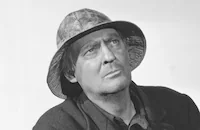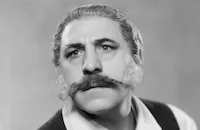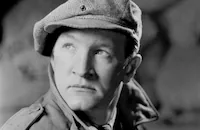Arséne Lupin

Brief Synopsis
Cast & Crew
Jack Conway
John Barrymore
Lionel Barrymore
Karen Morley
John Miljan
Tully Marshall
Film Details
Technical Specs

Synopsis
Just after a robbery has been reported at the home of Parisian millionaire Gourney-Martin, police detective Guerchard and his men chase a fleeing car, only to find the passenger tied up and claiming to have been robbed. Guerchard is convinced that the man is notorious jewel thief Arséne Lupin, although he claims to be the Duke of Charmerace. Gourney-Martin later confirms the duke's identity, then laughs because all his valuables are safely hidden at his country estate. The next day Guerchard is perplexed to discover that footprint impressions of the thief found outside Gourney-Martin's home, actually came from his own shoes. He then receives a note from Lupin saying that he will be at the duke's ball that night, so Guerchard decides to go himself. At the party, the duke, who really is Lupin, is confronted first by bailiffs supposed to collect past due bills, then by a beautiful woman, Sonia, Countess Krichnoff, lying in his bed. Later, when he has a birthday cake brought into the ballroom while the lights are out, many of the guests are robbed and Guerchard is certain that the duke is indeed Lupin. Later, Gourney-Martin invites Lupin and Sonia to his country estate for the weekend. Sonia, whose real identity is petty thief Sophie Krellberg, is secretly working for Guerchard to obtain her release from prison. Late that night, at Gourney-Martin's estate, Lupin goes to his host's study and watches as Gourney-Martin demonstrates the electrical shock feature of his burglar-proof safe. As Lupin returns to his room, he finds Sonia, who pretends to sleep walk, and he pours water on her. The next morning, she finds that her fake diamond bracelet has been replaced by a real one, then Gourney-Martin receives a note signed "Arséne Lupin" threatening to steal everything from him because he was a war profiteer. That night, Lupin pretends to sleep walk into Sonia's room, but instead of throwing him out she warns him to stay upstairs as she knows Guerchard is in the house. The next morning, Gourney-Martin discovers that his safe has been robbed. Although some of Lupin's cohorts are captured, none will name him, despite Guerchard's entreaties and threats, and even Sonia stands by her statement that "the duke" spent the entire night in her bedroom. Just as Guerchard threatens to return Sonia to prison, a rock comes through the window bearing a note from Lupin saying that he will steal The Mona Lisa from the Louvre Museum the next day. During the confusion, Lupin and Sonia drive off, then he goes to a hideout outside of Paris to plan the robbery. The next day, despite the precautions of Guerchard, the painting is stolen when Lupin's careful planning results in a series of diversions. He is able to get away because he has changed identities with an old flower vendor named Laurent. Though he is frustrated by the theft, Guerchard finally realizes that he can capture his nemesis by following Laurent's horse to Lupin's hideout. As Guerchard approaches, Lupin handcuffs himself to Sonia and tells the detective that she captured him. He then offers to exchange the painting for the release of Guerchard's daughter Maria, who, unknown to her father, has been kidnapped. Though Guerchard makes no deal, Lupin releases Maria and goes with the detective. On the drive to headquarters, Guerchard mentions that he once lost a prisoner who lept into the Seine, and Lupin quickly makes a break for the river. Later, Guerchard tells the Prefect of police that he fired four shots and heard Lupin scream. In a jewelry store, as Lupin and Sonia shop for gold rings, Lupin jokingly says "wouldn't old Guerchard love to see me buying jewelry?"

Director

Jack Conway
Cast

John Barrymore

Lionel Barrymore

Karen Morley

John Miljan

Tully Marshall

Henry Armetta
George Davis
John Davidson
James Macy
Mary Jane Irving

Joe Sawyer

Mischa Auer
Crew

Videos
Movie Clip



Hosted Intro
Film Details
Technical Specs

Quotes
Trivia
Notes
The play Arséne Lupin was based on the book of the same name by Maurice Leblanc, first published in Paris in 1907. There is some dispute concerning the origins of an American version of the play by Paul Potter. (For information about the dispute, see the entry on Arséne Lupin made in 1917 by Vitagraph, AFI Catalog of Feature Films, 1911-20; F1.0153). Variety lists a running time of 64 min. in its review of the film, however, this was probably a typographical error as it was 9 reels long and all other sources consulted listed it at 84 min. According to news items in Hollywood Reporter, Robert Montgomery and John Gilbert were both considered for the starring role in the film. The news item on Gilbert noted that Joseph Jackson was being borrowed from Warner Bros. to write a continuity for the film, but he did not receive a writing credit in any available sources for the film. A Film Daily news item announced that Herbert Prior had been added to the cast, but his participation in the completed film has not been determined. This was the first of four films in which brothers John and Lionel Barrymore appeared together in the 1930s. Although many sources, both contemporary and modern, called this their "first film together," they appeared, along with their sister Ethel, in a filmed version of an allegorical pageant entitled National Red Cross Pageant in 1917 (see AFI Catalog of Feature Films, 1911-20; F1.0153). According to New York Times, the 1932 film marked the first time they had acted together since they performed in the 1919 play The Jest. The week that the film opened, Time magazine featured them on their cover. Other films in which they co-stared were, Grand Hotel, released later in 1932, and Dinner at Eight, and Rasputin and the Empress, both released in 1933. Rasputin and the Empress also co-starred Ethel Barrymore. There have been many films featuring the character Arséne Lupin. In addition to the forementioned 1917 film, there was a 1916 British picture directed by George Loane Tucker, a 1919 Famous Players-Lasky film entitled The Teeth of the Tiger, a 1920 Christie Film production called 813 (see AFI Catalog of Feature Films, 1911-20; F1. 4375 and F1.1149), a 1921 Hungarian version entitled Arséne Lupin Utolso Kalandja, a 1923 Japanese film entitled 813, a 1938 M-G-M production starring Melvyn Douglas called Arsene Lupin Returns (see below) and a 1957 French film, Les Aventures d'Arséne Lupin directed by Jacques Becker. Tully Marshall, who played Gourney-Martin in this version, had a small part as the old pawnbroker Papa Monelle in the 1938 film.














